Many printing companies have invested hundreds of thousands of
dollars for digital printers and flatbed cutters only to find the
next difficulty is packaging their product for shipment to their
clients.
Sweetcutspro.com has been designed to address this specialized
packaging with a program (Sweetcuts) that will create cut files for
the manufacture of corrugated boxes using a browser, PDF capable
cutting software, a flatbed cutter and corrugated media. The
Sweetcut tools are made available as web fill out forms.
A registered user inputs length, width, and height measured from an
item to be boxed. On some forms, additional options are available
and can be modified to meet the users needs. When the "Create PDF
File" is clicked, a PDF is generated for download to the user.
The downloaded PDF contains a Register, Crease and Through cut
layer.
By design Sweetcuts, takes into account the users media size to
design and build the best box that fits the media and the item to be
packaged. Even when a entire covering cannot be achieved
within the media size, partial boxes are still created usually
leaving an area to be filled with a rectangular filler piece or
piecing two halves together .
Boxes made with Sweetcuts are designed to best the utilize media,
avoiding the need for any prepress alterations.
The primary media used in designing Sweetcuts was 200# .160 thick
single wall C flute .
One of the simplest and very effective box designs is the
center-joint box.
The center-joint box is a one piece corrugated box; however,
Sweetcuts has options to chose when the design exceeds the size of
media.
The following pictures are made using Sweetcuts center-joint. The
dimensions chosen are to show some of the variations possible of
using this tool.
The Register layer is intentionally left blank to eliminate an extra
step when cutting software needs it to read the edges of media.
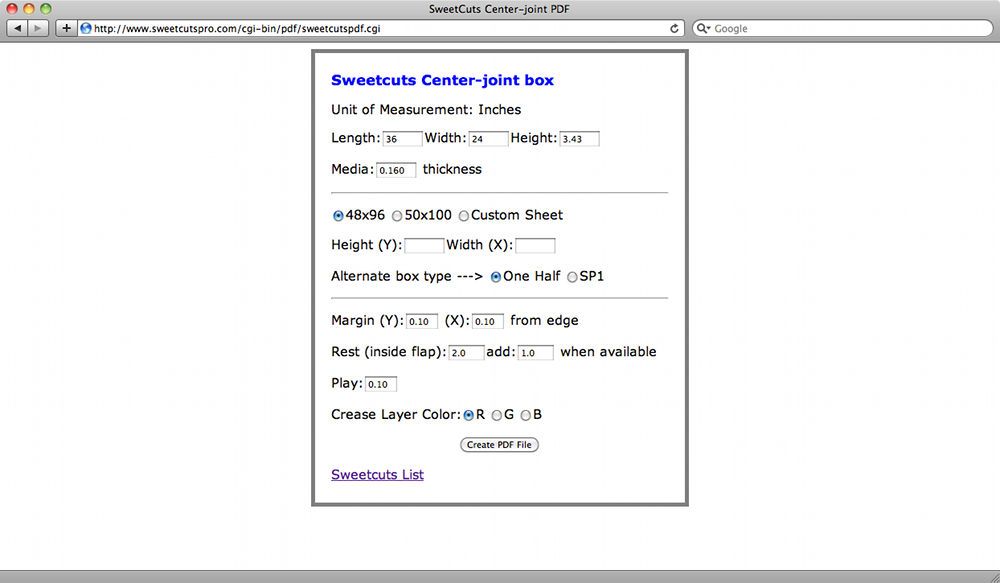
Above:
First line Sweetcuts (tool) Center-joint box (name of box design
form creates)
Unit of Measurement = Inches
User enters data in the Length, Width and Height form fields.
By default a 48x96 inch sheet is selected a radio button can be
switched to 50x100 or a custom sheet
The margin from edge fields is deigned to avoid using factory edges
and moves cuts that far from 0y 0x of the media (lower left)
The rest by default is set to 2 inches with an add 1 when available.
The user can change these fields prior to "Creating a PDF" less rest
can make a box fit within the media and add when available is there
for easier folding
The play field adds itself to length, width and height fields.
That's about the thickness of a dime, which would fit on both sides
whether length,width or height. However some distortion occurs when
folding which may make a less than dimensionally correct box.
Sweetcuts has other calculations built in though to compensate for
those distortions.
Note: Sweetcuts built in compensation has not
been tested on thicker or thinner media.
The Crease layer color can be changed by selecting another button
(crease color is preset to RED)
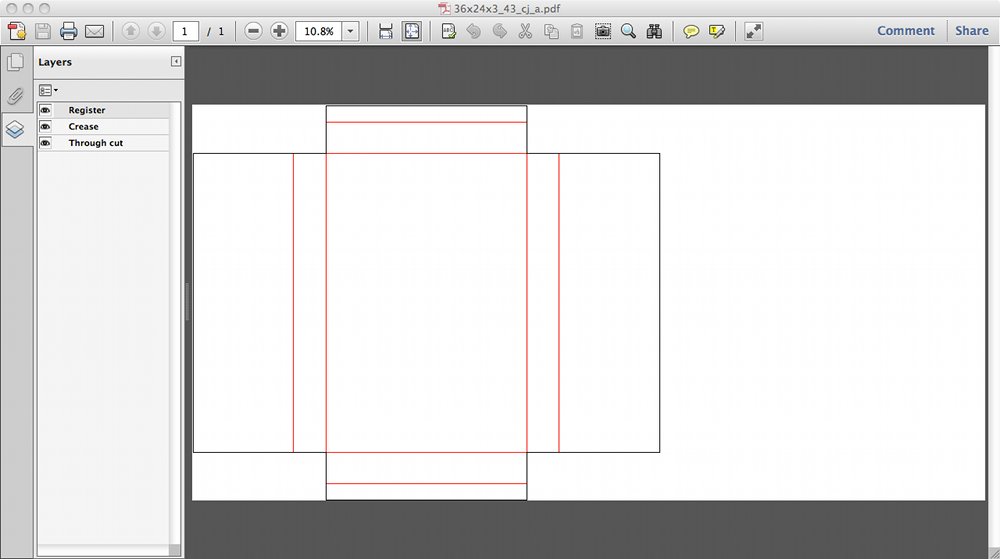
Above:
File Naming
At the top of this picture you will see the PDF file name
36x24x3_43_cj_a.pdf
The first number 36 is the length that was entered followed by a
lowercase x
next is 24 which is the width that was entered followed by a
lowercase x
next is 3_43 which is the height that was entered (decimal points or
dots are replaced with an underscore) 3.43 was the entered height
next _cj (underscore cj) means center-joint
next _a (underscore a) means the length of the box fits within the
media height (y direction)
Note: the combined length of
36 in. and 3.43 in. with 2 in. rests was the maximum for this media
height (48 in.)
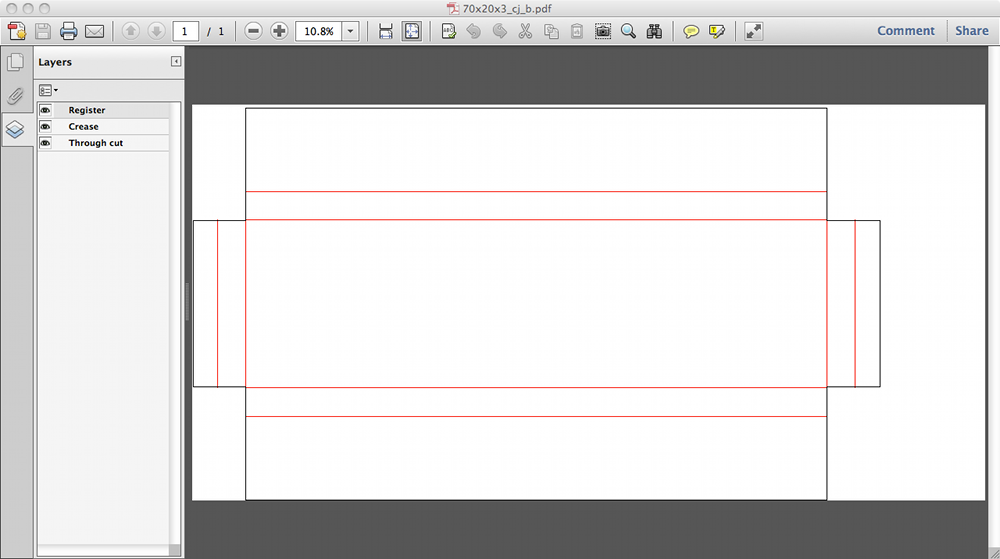
Above:
This PDF show dimension 70 length 20 width and 3 height.
Note: The rest flaps were also increased by the
preset of 1in. for a total 3 inches
The _b indicates that the length of the box fits in media width (x
direction)
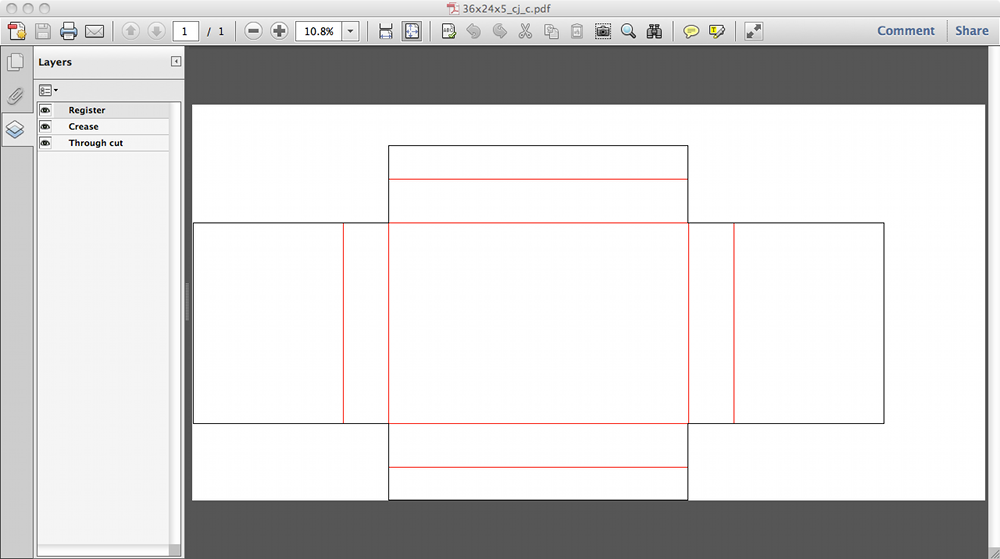
Above:
Similar to the first box (36x24x3_43_cj_a.pdf) the length is still
36 in. but now Sweetcuts utilizes the media in the opposite
direction for the length
Note: The seam is parallel to the width. It was
the added height that forced the rotation. Also the available media
allowed for the rest to increase another 1 inch.
The _c is to indicate that the length fits the media width (96 in.)
and the seam is parallel to width
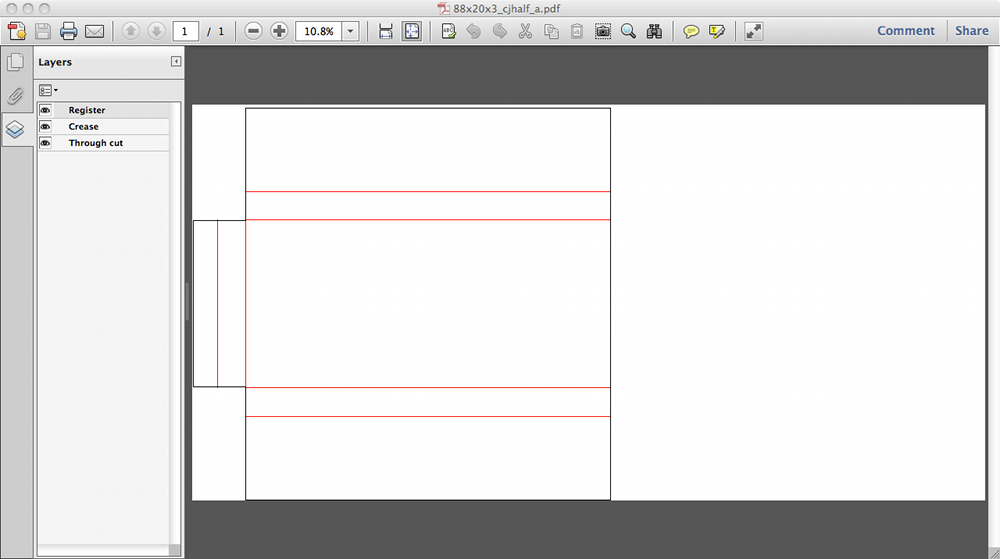
Above: 88x20x3_cjhalf
This is one half of a box indicated by it's file name
88x20x3_cjhalf_a.pdf. It is produced when the alternative box
type One half is selected (preset).
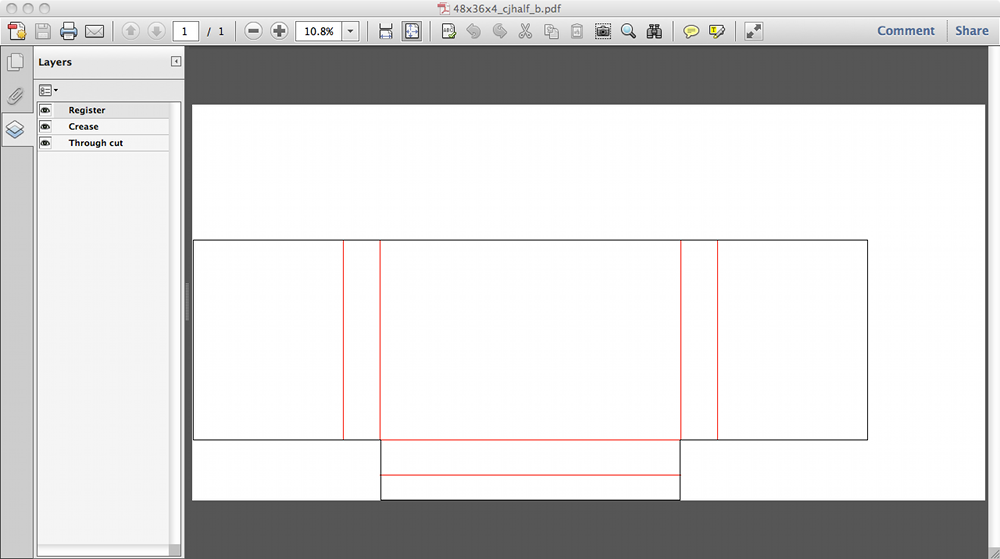
Above: 48x36x4_cjhalf_b.pdf
This image displays one half box for a 48x36x4 in. center-joint.
Also One half button was selected and 1 inch added to
the rest which are preset.
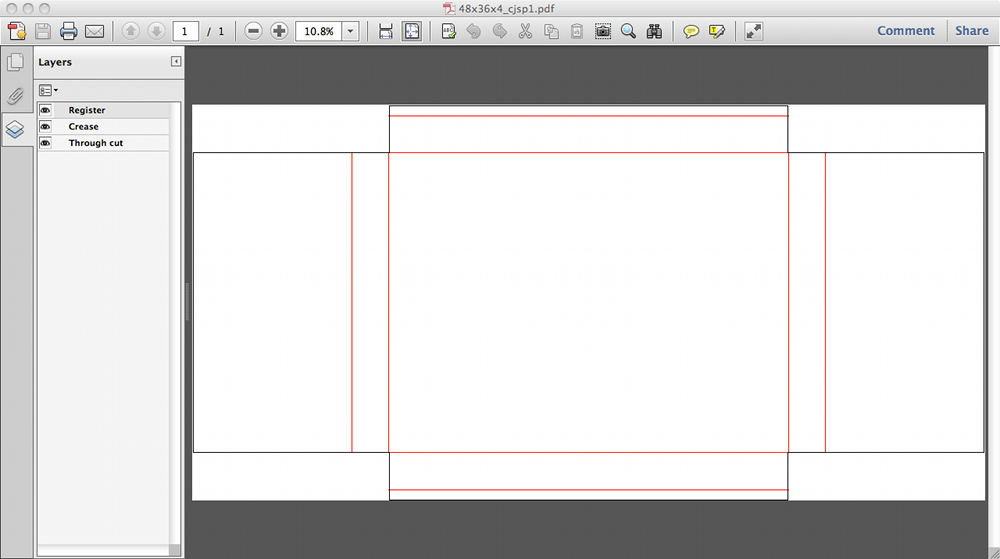
Above: 48x36x4_cjsp1.pdf
The SP1 button utilizes the media within the x and y margins (preset
at 0.10) creating the largest enclosure possible.
To fully enclose an additional piece approximately 36x4 in. would be
needed.
Note: Similar in design is the SP1 form located
at www.sweetcutspro.com/cgi-bin/pdf/sweetcuts_sp1.cgi,
which is made to use the media edges and avoid several cuts (next
picture).
Also if a "SP1" is made from the center-joint
form, the file name ends with _cjsp1.pdf.
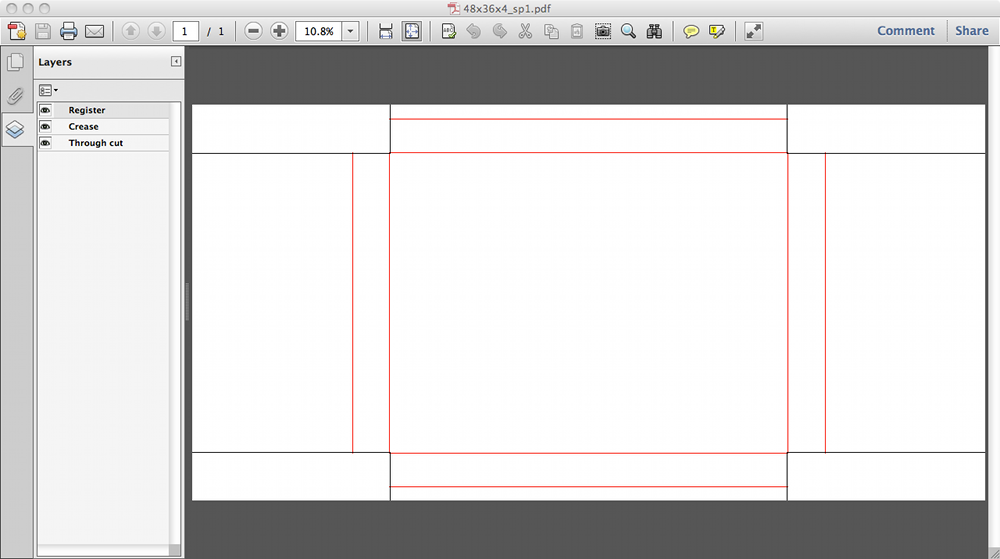
Above: 48x36x4_sp1.pdf
The SP1 form utilizes the media edges, which reduces cuts, has less
weed to remove and minimally makes better use of the media compared
to a center-joint SP1.
Note: To fully enclose an additional piece
approximately 36x4 in. would be needed.
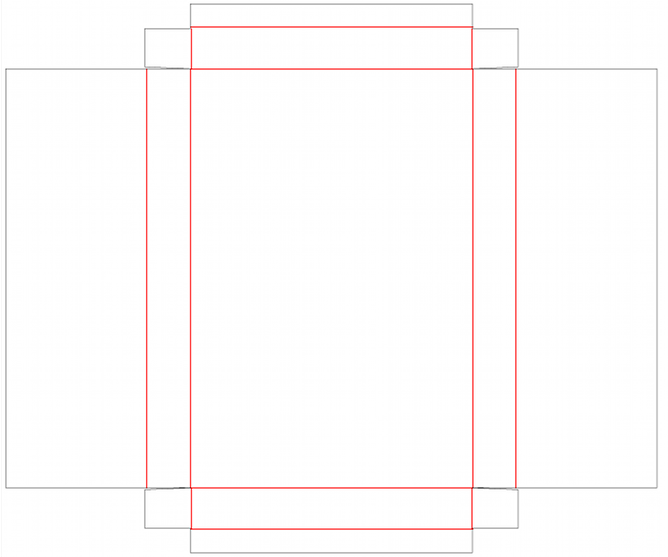
Above:36x24x3_4_cjdf_a.pdf (lines only no Adobe Reader window
showing)
This picture show a center-joint box created with dust flaps.
CENTER-JOINT with DUST FLAPS is LIMITED. It only creates a file
within the media available.
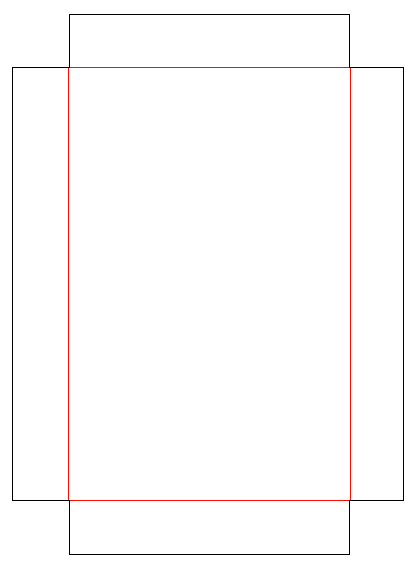
The picture above represents a top or bottom box file. It is
sometimes referred to as a tray box or telescopic box.
Note: One half of a box is created when the media
is too small.
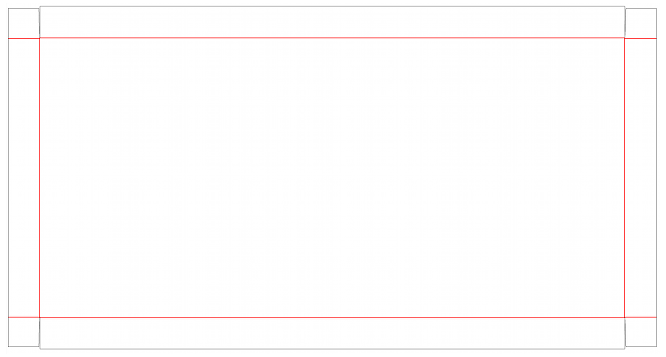
The picture above represents a top or bottom with dust flaps box
file. It is sometimes referred to as a tray box or telescopic box.
Note: One half of a box is created when the media
is to small.

Above is a screen shot of 4x3 in. edges. The red lines are creases
and the gray lines are through cuts. They can be folded into a U
channel to protect edges, and before or afterwards blank
sheets can be added to both sides of the item to be packaged for a
fully covering.
The dual part of these edges is when they are folded and taped to
make a triangular tube. They are often placed around the perimeter
of a lightweight poster to protect it from contact with the edges of
an outer box.











